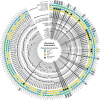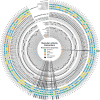A systematic review of movement and muscular activity biomarkers to discriminate non-specific chronic low back pain patients from an asymptomatic population
- PMID: 33712658
- PMCID: PMC7955136
- DOI: 10.1038/s41598-021-84034-x
A systematic review of movement and muscular activity biomarkers to discriminate non-specific chronic low back pain patients from an asymptomatic population
Abstract
The identification of relevant and valid biomarkers to distinguish patients with non-specific chronic low back pain (NSCLBP) from an asymptomatic population in terms of musculoskeletal factors could contribute to patient follow-up and to evaluate therapeutic strategies. Several parameters related to movement and/or muscular activity impairments have been proposed in the literature in that respect. In this article, we propose a systematic and comprehensive review of these parameters (i.e. potential biomarkers) and related measurement properties. This systematic review (PROSPERO registration number: CRD42020144877) was conducted in Medline, Embase, and Web of Knowledge databases until July 2019. In the included studies, all movements or muscular activity parameters having demonstrated at least a moderate level of construct validity were defined as biomarkers, and their measurement properties were assessed. In total, 92 studies were included. This allowed to identify 121 movement and 150 muscular activity biomarkers. An extensive measurement properties assessment was found in 31 movement and 14 muscular activity biomarkers. On the whole, these biomarkers support the primary biomechanical concepts proposed for low back pain. However, a consensus concerning a robust and standardised biomechanical approach to assess low back pain is needed.
Conflict of interest statement
The authors declare no competing interests.
Figures





Similar articles
-
Measurement properties of 72 movement biomarkers aiming to discriminate non‑specific chronic low back pain patients from an asymptomatic population.Sci Rep. 2023 Apr 20;13(1):6483. doi: 10.1038/s41598-023-33504-5. Sci Rep. 2023. PMID: 37081110 Free PMC article.
-
Asymmetry of lumbar muscles fatigability with non-specific chronic low back pain patients.Eur Spine J. 2019 Nov;28(11):2526-2534. doi: 10.1007/s00586-019-06140-9. Epub 2019 Sep 13. Eur Spine J. 2019. PMID: 31520128
-
The Standardised Mensendieck Test as a tool for evaluation of movement quality in patients with nonspecific chronic low back pain.Scand J Pain. 2018 Apr 25;18(2):203-210. doi: 10.1515/sjpain-2018-0028. Scand J Pain. 2018. PMID: 29794292
-
A systematic review of the role of inflammatory biomarkers in acute, subacute and chronic non-specific low back pain.BMC Musculoskelet Disord. 2020 Mar 3;21(1):142. doi: 10.1186/s12891-020-3154-3. BMC Musculoskelet Disord. 2020. PMID: 32126991 Free PMC article.
-
Does Movement Change When Low Back Pain Changes? A Systematic Review.J Orthop Sports Phys Ther. 2020 Dec;50(12):664-670. doi: 10.2519/jospt.2020.9635. Epub 2020 Oct 28. J Orthop Sports Phys Ther. 2020. PMID: 33115341
Cited by
-
Core Synergies Measured with Ultrasound in Subjects with Chronic Non-Specific Low Back Pain and Healthy Subjects: A Systematic Review.Sensors (Basel). 2022 Nov 10;22(22):8684. doi: 10.3390/s22228684. Sensors (Basel). 2022. PMID: 36433283 Free PMC article.
-
Marked differences between continuous long-term and clinical snapshot examinations: is the current standard of back pain diagnostics outdated?Front Bioeng Biotechnol. 2024 Jul 25;12:1411958. doi: 10.3389/fbioe.2024.1411958. eCollection 2024. Front Bioeng Biotechnol. 2024. PMID: 39119273 Free PMC article.
-
Measurement properties of 72 movement biomarkers aiming to discriminate non‑specific chronic low back pain patients from an asymptomatic population.Sci Rep. 2023 Apr 20;13(1):6483. doi: 10.1038/s41598-023-33504-5. Sci Rep. 2023. PMID: 37081110 Free PMC article.
-
Regional flexion relaxation phenomenon in lumbar extensor muscles under delayed-onset muscle soreness: high-density surface electromyography insights.Eur J Appl Physiol. 2025 May;125(5):1323-1336. doi: 10.1007/s00421-024-05678-x. Epub 2024 Dec 11. Eur J Appl Physiol. 2025. PMID: 39661114
-
Real-time ultrasound evaluation of CORE muscle activity in a simultaneous contraction in subjects with non-specific low back pain and without low-back pain. Protocol of an observational case-control study.PLoS One. 2023 Aug 10;18(8):e0285441. doi: 10.1371/journal.pone.0285441. eCollection 2023. PLoS One. 2023. PMID: 37561752 Free PMC article.
References
-
- Vos T, et al. Global, regional, and national incidence, prevalence, and years lived with disability for 328 diseases and injuries for 195 countries, 1990–2016: a systematic analysis for the Global Burden of Disease Study 2016. The Lancet. 2017;390:1211–1259. doi: 10.1016/s0140-6736(17)32154-2. - DOI - PMC - PubMed
Publication types
MeSH terms
Substances
Grants and funding
LinkOut - more resources
Full Text Sources
Other Literature Sources
Medical

